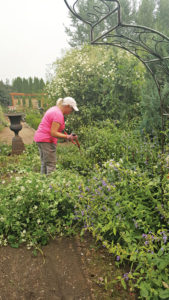Fall has arrived here on the west plains and winter is close behind. Every year we receive many questions about how to winterize the garden. Here are four tips on how to prepare for the cold season ahead.
The best time to begin winterizing your garden is after the first hard freeze in the fall. For the west plains around Paradise Prairie, a hard freeze usually arrives in late September to late October. The garden is well on its way to winter by November.
The most important thing you can do to winterize your garden is to ensure that the garden is well hydrated before freezing temperatures set in. At the Rosarium we are actively watering our garden now and won’t turn off the irrigation until temperature fall below 32 degrees. It may not be possible for everyone to water late in the season, especially if you are scheduled with a company to blow out your irrigation system. If this is the case, you will greatly benefit evergreens ornamental trees, shrubs, roses, and perennials by hand watering them before the freeze. Often evergreens that look burned or damaged in the spring are the result of lack of moisture before winter. This fall we discovered bone dry soil in our garden as deep as three feet and probably deeper. The lack of autumn rains has left our yards in very dry conditions. But we have noticed a remarkable difference in our evergreens and roses if we water them in well before they freeze.
In our display garden at the Rosarium we grow over 2,000 rose plants, a huge variety of perennials, decorative shrubs, hydrangeas as tall as trees, and some of our favorite flowering trees each year. We try to get a modest layer of mulch or compost on the ground in order to enrich the soil which helps to preserve moisture during these dry times. Enriching your soil holds moisture, naturally suppresses weeds and builds up your soil for better spring blooms.
We fertilize the entire garden in the spring when we are cleaning up and fertilize again in July. This results in healthy plants going into fall and winter. After July, we do not recommend fertilizing because we want the plants to make use of the fertilizer during the growing season and then slow their growth and begin dormancy as shorter days and colder temperatures signal the start of winter.
When it comes to cleaning up the garden for winter, there are several things to consider. Many plants have a wonderful winter personality and interest; such as grasses, plants with seed pods, roses with hips, and bushes with berries. A clump of grass waving in the winter breeze can be attractive to the eye. There will be plenty of time in the spring to trim back grasses and winter shrubs before new shoots come up in spring. Autumn Joy Sedum, Purple Coneflowers, and Russian Sage are good options with winter interest.
Cutting back your garden in the fall will prevent diseases and insects from making their homes in the dead plant material over winter. Clip down perennials like hardy geraniums, nepta, and hostas that can be trimmed back to the ground before winter. Remove annuals that have frosted and add to the compost pile. Replace them with fall mums and winter cabbage that may live until spring. However, it is important to remove leaves from your grasses and garden beds because they can harbor disease over the winter. The clippings are great for composting and tilling into your vegetable garden.
We prune most of our roses in the spring and take time in the fall to tie up the canes of climbing roses to prevent damage from snow and wind. If you have grafted roses, it is important to cover the crown of the root with 6 to 12 inches of compost, bark, mulch, or soil. We don’t recommend straw or leaves as these materials attract rodents and disease. If you are growing own-root roses like we grow at the Rosarium, no special care is needed for them before winter. Our own-root roses – and any own-root plants – are hardy for the west plains and Spokane winters because their roots are strong and well established.
Steps for a happy winter garden and healthy spring blooms:
• Plenty of water for everything
• Enrich your soil with mulch or compost
• Prune and clear old materials
• Grow own-roots!
Happy gardening. Remember – no rain, no flowers!
Carol Newcomb, Master Gardener and Rosarian
Northland Rosarium
 Carol Newcomb and her husband Terry have been owners of Northland Rosarium for 15 years. Carol grew up in North Spokane learning how to garden in her parent’s large flower and vegetable gardens. She became a Master Gardener in Bonner County and contributed to several public gardens while pursuing her first love of growing English delphiniums. After she completed her degree in horticulture, she purchased the Rosarium and transformed it from a small local shop to a full service nursery, offering specialty clematis, perennials, conifers and trees, statuary and metalwork, and shipping thousands of roses per year across the U.S. In her spare time, Carol cultivates the 2.5 acre display garden in Spokane which has thousands of roses and unique features enjoyed by visitors from all over the country. Growing plants has been a lifelong love for the Newcombs and continues to this day.
Carol Newcomb and her husband Terry have been owners of Northland Rosarium for 15 years. Carol grew up in North Spokane learning how to garden in her parent’s large flower and vegetable gardens. She became a Master Gardener in Bonner County and contributed to several public gardens while pursuing her first love of growing English delphiniums. After she completed her degree in horticulture, she purchased the Rosarium and transformed it from a small local shop to a full service nursery, offering specialty clematis, perennials, conifers and trees, statuary and metalwork, and shipping thousands of roses per year across the U.S. In her spare time, Carol cultivates the 2.5 acre display garden in Spokane which has thousands of roses and unique features enjoyed by visitors from all over the country. Growing plants has been a lifelong love for the Newcombs and continues to this day.
Northland Rosarium – www.northlandrosarium.com
9405 S. Williams Lane, Spokane WA 99224
509-448-4968 – [email protected]


